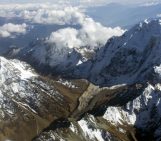
Name of proxy
Varved glacial lake sediments
Type of record
Sedimentological structures
Paleoenvironment
Ice marginal lake environments
Period of time investigated
Last Glacial Termination (LGT, c.21-14 thousands of years (ka)) to present times
How do varves work?
Proglacial lakes form in front of glaciers and act as sinks for water and sediment flowing from melting ice. Analyses of proglacial lake sediments enable continuous reconstructions of glacial and foreland environmental change, including annually resolved (varved) records.
Varves typically consist of two layers, a coarse sand or silt layer capped with a fine grained clay layer separated by a sharp contact (fig. 2). Varves form due to seasonal fluctuations in glacial environments. These include processes like meltwater and sediment input, lake ice cover, wind shear and precipitation. The relative age of a varved sequence can then be counted as this repeating cycle means each pair of layers represents a single years’ worth of deposition (Ashley, 1995). The ability to count a single year from thousands of years ago far exceeds the resolution achievable from other dating techniques, which may have error bars of hundreds to thousands of years.
Another advantage of using varves is that they form in glacial lakes with very little biological activity. Many other proxies and dating techniques rely on biologically produced matter and cannot be used to study environments very close to glaciers. These areas are often key in understanding ice-sheet behaviour and is another reason varves are an important tool in environmental reconstructions.

Figure 2. (a.) Varved sediment sequence from Central Ireland displaying rhythmic sedimentation of a coarse silt layer capped with a fine a clay layer. (b.) Scanning electron microscope image of the sharp contact separating the two laminae in a couplet. Source: Delaney et al. (2009)
Many glacial lakes formed during the Last Glacial Termination (LGT, c.21-14 ka) as large terrestrial ice-sheets retreated or melted entirely. In areas such as the British Isles there is no remnant of ice; however many sites of paleo-lake sediments are preserved. Analyses of these sediments allow the environmental impact and rate of ice retreat to be modelled. This can be used to constrain timing of periods of ice growth and decay or can be correlated with paleo-temperature records from ice cores to model ice-sheet response to temperature change.
Key findings
Varves allow for a continuous record of environmental change to be constructed and provide a method of calculating the rate of these changes. Due to this, they are an ideal proxy for reconstructing paleo-ice environments from the LGT and subsequent glacial re-advances at sites that no longer support ice-sheets.
Varved sediment sequences in the British Isles have been used to constrain dating of ice advances and retreat. During a period of glaciation biological activity shuts down and environmental indicators such as pollen or insect remains cannot be used. Varves are then used to bridge these gaps and provide a method of calculating how long glacial periods lasted. An example of this is the precise dating of the onset and duration of ice advance during the Younger Dryas cold period in Scotland (12.6-11.5 ka) using varved sequences (MacLeod et al., 2011).
As well as paleo-records, modern glacial lakes may also contain varved sediments. These records can provide insights into anthropogenic impacts on glaciers and glaciated environments. Modern varve records can also be correlated with meteorological records and lake monitoring to refine the model of varve formation and controls on glacial lake sedimentology.
Correlating meteorological conditions with varve characteristics has shown that local climate processes, such as precipitation (Cockburn and Lamoureux, 2007) and snow melt (Leemann and Niessen, 1994), can be recorded and reconstructed from varves. This means that records of climate covering the last hundreds or thousands of years can be extracted from lakes and used to determine how they have changed with increasing human impacts on the Earth’s climate. Through the use of models of paleo-environmental change and more recent records of lake dynamics, varves provide a method of prediciting the future behaviour of ice sheet response to climate warming.
Edited by the editorial board
References
Ashley, G. M. (1995) ‘Glaciolacustrine Environments.’ In Menzies, J. (ed.) Glacial Environments, vol. 1: Modern Glacial Environments. Processes Dynamics and Sediments,. Oxford: Butterworth Heinemann, pp. 417–444.
Cockburn, J. M. H. and Lamoureux, S. (2007) ‘Century-scale variability in late-summer rainfall events recorded over seven centuries in subannually laminated lacustrine sediments, White Pass, British Columbia.’ Quaternary Research, 67(2) pp. 193–203.
Delaney, C., Hambrey, M., Christoffersen, P., Glasser, N. and Hubbard, B. (2009) ‘Seasonal controls on deposition of Late Devensian glaciolacustrine sediments , Central ireland : Implications for the construction of a varve chronology for the British-Irish ice-sheet Seasonal Controls on Deposition of Late Devensian.’ In Glacial sedimentary processes and products. Oxford: Wiley-Blackwell, pp. 149–163.
Leemann, a. and Niessen, F. (1994) ‘Varve formation and the climatic record in an Alpine proglacial lake: calibrating annually- laminated sediments against hydrological and meteorological data.’ The Holocene, 4(1) pp. 1–8.
MacLeod, A., Palmer, A., Lowe, J., Rose, J., Bryant, C. and Merritt, J. (2011) ‘Timing of glacier response to Younger Dryas climatic cooling in Scotland.’ Global and Planetary Change. Elsevier B.V., 79(3–4) pp. 264–274.


guy dumas
i have a question.. Around my house , there are varves in sand pits,, but they are not horizontal, more like softly curved… Were they originaly made that way of were they horizontal at first..